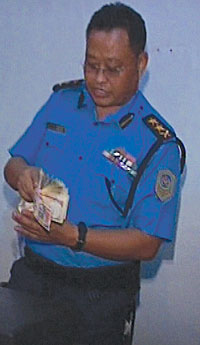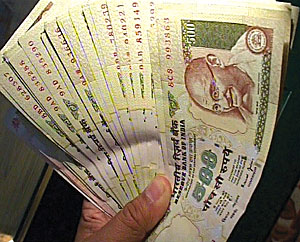 FUNNY MONEY: Birganj SP Yogeswor Romkhami shows fake notes seized at the border. |
This counterfeit currency racket has vast tentacles with links to international terrorism and crime. The only reason Nepal is a transit point is because of the ease with which Kathmandu airport can be used to smuggle things in and out, and the open poorly-guarded border between Nepal and India. The irony of it is that even real Indian 500 and 1,000 rupee notes are banned in Nepal.
Our investigation shows that every day, some Rs 30 million is being taken across from Birganj to Raxaul in bicycles, rickshas and tangas. Couriers are paid IRs 500 (in real money) for every bundle of fake Rs 100,000 that they take across. Dealers in India buy every fake IRs 1,000 note for IRs 700 and they pass them on to retailers across the country.
Fake cash is now appearing in ATMs as far afield as Bangalore and Chennai. Indian sources say that at this rate, there will be IRs 100 billion fake currency in circulation in the next two years. Nepal is also affected because the Indian rupee is used widely in the Tarai. The political instability in Nepal and the criminalisation of politics in the Tarai have abetted the smuggling. The porous Indo-Nepal border, always a haven for smugglers, just has another contraband to push fake cash.
 RAJESH BHARDWAJ RICH PAPER: A wad of Indian 500 rupee notes from a consignment of counterfeit currency . |
Till a few years ago, the notes looked fake: they had thicker paper, shoddy printing and didn't feel right. But lately, counterfeiters are using sophisticated presses in Thailand and Bangladesh and have incorporated watermarks, security threads and even got the subtle tints in the ink right. Indian security officials say foreign governments are out to subvert the Indian economy and suspect terror groups with links to Dawood Ibrahim 'D Company' are involved.
Yogewsor Romkhami displays some fake notes, and says: "Even I can't tell which is real or which is fake. There must be some countries or agencies involved, but I can't say anything sitting in this chair."
VK Shashikumar in Birganj
SEE ALSO
http://www.nepalitimes.com/issue/2008/10/31/Nation/15337


